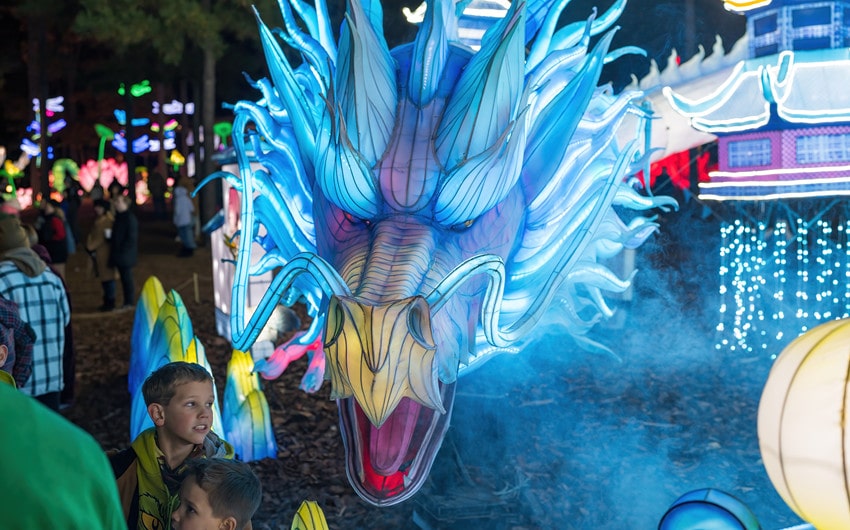Tracing the Light and Shadow: The Millennium Evolution and Cultural Heritage of Chinese Lanterns
Whenever twilight descends and the lights come on, that warm and dazzling glow always seems to transcend time and space, rousing the deepest resonance in people’s hearts. In China, lanterns have long surpassed the function of mere lighting tools; they are the soul of festivals, the crystallization of art, a cultural symbol, and a poetic sentiment flowing in the nation’s bloodline. As ForestPaintingLantern, a world-leading expert in custom lantern design, we not only inherit the essence of this ancient craftsmanship but are also committed to bringing this Oriental aesthetic of light and shadow to the world. Today, let us draw back the veil of history and explore the fascinating origins of Chinese lanterns together.
Ⅰ. A Spark is Ignited: The Origin of Utility and Vague Legends (Antiquity to Qin and Han Dynasties)
The birth of the lantern first stemmed from humanity’s most primal need: to dispel darkness and bring light and safety.
Inspiration from Primitive Fire: Ancient ancestors found warmth and protection around bonfires, but these fires were stationary and difficult to move. To carry a light source during migration, hunting, or nighttime activities, people began using natural materials like hollow gourds, scooped-out fruits, or woven wicker baskets to hold burning resin, animal fat, or simple torches. These rudimentary “container lamps” can be considered the earliest form of lanterns, with their core function being to protect the fire, shield it from wind and rain, and make it easy to carry.
The Name “Lantern” and Material Evolution: The Chinese character for “lantern,” 笼 (lóng), inherently means “to wrap” or “to cover”. With the development of productive forces, especially the emergence and popularization of silk (around the Shang and Zhou dynasties), this lightweight, tough and somewhat translucent high-quality fabric gradually replaced natural fruits and became the ideal material for making lampshades.. By creating a frame from bamboo strips or wood, covering it with silk, and placing a candle or oil lamp inside, a true “lantern” was born. The application of silk was a crucial leap in the history of lantern development, as it not only improved practicality but also injected the initial aesthetic value.
Emperors and Deities: Early Cultural Symbols: The early use of lanterns was often linked to rituals and power. Legend has it that Emperor Wu of Han, during the Western Han Dynasty, would light lamps all night long on the fifteenth day of the first lunar month to worship “Taiyi” (the God of Heaven), praying for national prosperity and favorable weather. This magnificent scene of lights is regarded by later generations as one of the important origins of the custom of lighting lanterns during the Lantern Festival. At this time, lanterns began to carry cultural connotations of praying for blessings, honoring deities, and demonstrating royal authority.
Ⅱ. The Eastern Spread of Buddhism: Religious Empowerment and the Embryo of Festivals (Wei, Jin, Southern and Northern Dynasties)
Buddhism was introduced to China during the Eastern Han Dynasty and flourished during the Wei, Jin, and Southern and Northern Dynasties. Buddhist culture provided a revolutionary impetus for the development of lanterns.
The Ritual of “Lighting Lamps to Honor the Buddha”: In Buddhist teachings, the lamp symbolizes wisdom and light, capable of dispelling ignorance and darkness. Scriptures like the Jataka Stories of the Bodhisattva contain numerous records of lighting lamps to make offerings to the Buddha to accumulate merit and receive blessings. Monasteries became important places for using and displaying lanterns. On significant Buddhist holidays such as the Buddha’s birthday and the Ullambana Festival, a large number of lanterns would be lit inside and outside the temples, creating a solemn and sacred atmosphere. The combination of “lamp” and “Buddha” greatly enhanced the spiritual and sacred status of lanterns.
From Monasteries to the Populace: The spectacular sight of lanterns in temples attracted many people to watch and pray for blessings. This religious activity subtly influenced folk customs. People began hanging lanterns at home or in front of their doors on important days, such as during ancestor worship or when praying for good fortune. The spread of Buddhism accelerated the popularization of lanterns from the court and temples to broader society, laying the foundation for their future role as a symbol for national festivals.
The Budding of Technique and Decoration: To meet the solemn demands of religious ceremonies, the craftsmanship of lantern making began to become more refined. Besides silk, more translucent and durable gauze and paper (especially tough parchment) were widely used. Lantern shapes were no longer limited to simple circles or squares; they began to feature forms with Buddhist meanings, such as lotus flowers (symbolizing purity) and pagodas. Simple colored paintings also started to appear on the lantern surfaces.
Ⅲ. The Flourishing Era: The Establishment of the Lantern Festival and the Artistic Zenith (Sui, Tang, and Song Dynasties)
The Sui, Tang, and Song dynasties were the golden age of Chinese lantern culture. The official establishment and national celebration of the Lantern Festival pushed the lantern to its artistic peak.
1. The Legalization and Carnivalesque Nature of the Lantern Festival:
Emperor Yang of Sui’s “Vanity Project”: The extravagant Emperor Yang of Sui, in an effort to demonstrate national strength and share joy with the people, once hosted an unprecedented Lantern Festival celebration in Luoyang. It was described as “a thousand lights illuminating a lamp-tree, and seven branches of blossoming fireworks opening,” reaching the pinnacle of extravagance. Though a financial burden on the people, it objectively stimulated the improvement of lantern-making techniques and the scale of lantern fairs.
The Openness and Inclusiveness of the Tang Dynasty: The Tang Dynasty was at the height of its power and had an open society, so the custom of lighting lanterns for the Lantern Festival (Shangyuan Festival) received strong official support and promotion. During the reign of Emperor Xuanzong of Tang, the period for lighting lanterns was extended from one night to three nights (the fourteenth, fifteenth, and sixteenth) and the curfew was lifted, allowing people to watch the lanterns and celebrate all night. In major cities like Chang’an and Luoyang, lantern towers soared into the clouds and lantern trees dazzled with light. The streets were bustling with people, creating a truly national carnival. Lanterns became the most direct and brilliant footnote to the grandeur of the Tang Dynasty.
The Zenith and Urbanization of the Song Dynasty: The Song Dynasty saw a highly developed commodity economy and the rise of a citizen culture, with the Lantern Festival reaching an unprecedented scale and artistic height. The time for lighting lanterns was extended from three nights to five nights (or even longer), with grander scales and a greater variety of styles. The lantern markets in Bianjing (Kaifeng) and Lin’an (Hangzhou) were renowned. The author Meng Yuanlao noted in The Eastern Capital: A Dream of Splendor, “the lights on the mountains were resplendent, reflecting each other with gold and jade… with all sorts of ingenious and marvelous crafts, new and varied”. By this time, the lantern had fully integrated into urban life, becoming an indispensable core element of the festival.
Not only the Lantern Festival, but also lanterns can be seen at the celebrations of various traditional Chinese festivals
2. Leaps in Craftsmanship and Technology:
The Revolution of Materials: The Popularization of Paper: The papermaking technology of the Song Dynasty was mature, and tough, translucent, inexpensive, and easy-to-shape and decorate paper completely replaced silk as the main material for lantern shades. This greatly reduced the cost of lantern production, promoting their large-scale manufacturing and popularization.
A Myriad of Shapes and Forms: Lantern shapes were no longer confined to simple geometric figures and religious symbols. Artisans exercised boundless imagination to create palace lanterns, gauze lanterns, revolving lanterns (driven by hot air), dragon lanterns, fish lanterns, rabbit lanterns, lotus lanterns, hexagonal lanterns, spherical lanterns, and countless others. Animals, plants, figures, objects, and auspicious patterns could all be incorporated into the lanterns.
The Pinnacle of Decorative Arts: The decorative techniques on lantern surfaces became exquisite.
Painting: Fine brushwork and freehand styles were used to depict landscapes, figures, flowers, birds, and stories.
Paper-cutting (or Engraving): Exquisite paper-cut patterns were attached to the lantern shade, creating a unique silhouette effect when lit
Poetry and Calligraphy: Literati would inscribe poems and essays on the lanterns, adding a touch of scholarly elegance.
Riddles: In the Song Dynasty, it became popular to write riddles on lanterns for people to guess. This practice, known as “lantern riddles,” became a major intellectual entertainment during the Lantern Festival, greatly enhancing the cultural fun and participatory nature of lanterns.
3. The Diversification of Functions:
Besides illumination and festive decoration, lanterns in the Song Dynasty took on more functions.
Shop Signs (Hanging Banners): Shops open at night would hang lanterns of a specific shape or with their name written on them as a form of identification.
Symbols of Status: Lanterns of different materials, sizes, and craftsmanship symbolized the user’s status and wealth.
Information Carriers: Government offices and courier stations used lanterns of a specific style to transmit information or mark locations.
Ⅳ. Refined Craftsmanship and Folk Custom Accumulation (Yuan, Ming, and Qing Dynasties)
During the Yuan, Ming, and Qing dynasties, building upon the brilliance of the Tang and Song, lantern culture became more focused on refined craftsmanship, regional styles, and a deeper integration with folk customs.
The Exemplar of Palace Lanterns: In the Ming and Qing dynasties, particularly the Qing, the craftsmanship of palace lanterns reached its pinnacle. The materials were meticulously chosen (such as red sandalwood, rosewood, huanghuali wood, cloisonné enamel, jade, and ivory), the structures were ingenious (mortise and tenon joints, detachable parts), and the decorations were opulent (carvings, openwork, inlays, and paintings). Palace lanterns embodied both practicality and artistry, becoming one of the treasures representing the peak of Chinese applied arts. The palace lanterns in the collection of the Beijing Palace Museum are still breathtaking today.
The Formation of Regional Schools: Lantern making blossomed across the country, forming distinct local characteristics.
Beijing Palace Lanterns: Characterized by their dignity, splendor, and royal aura.
Xiashi Lanterns (Haining, Zhejiang): Famous for needle-pierced patterns, with fine needlework and thin, layered lamp sheets that are delicate and exquisite.
Quanzhou Filament Lanterns (Fujian): Known for their unique and beautiful frames woven with glass filaments.
Zigong Lantern Festival (Sichuan): While it gained fame in modern times, its foundation lies in a long history of lantern making. It is known for its magnificent large-scale lantern sets, intricate craftsmanship, and use of new materials, which laid the foundation for modern lantern art.
Foshan Colored Lanterns (Guangdong): Famous for their paper-cut patterns and copper-foil decorations, they are vibrant and auspicious.
Chaozhou Floral Lanterns: Noted for their complex craftsmanship and depictions of figures from stories.
The Solidification of Folk Festivals: The Lantern Festival became one of the most important national holidays of the year, and its customs (admiring lanterns, guessing lantern riddles, eating yuanxiao or tangyuan) became deeply rooted across the country and passed down through generations. In addition, lanterns played a significant role in life rituals and seasonal holidays, such as weddings (symbolizing adding new family members and joy), birthdays (symbolizing longevity), housewarmings (symbolizing brightness and prosperity), and the Ghost Festival (river lanterns expressing mourning). They became deeply integrated into the cultural genes and daily life of the Chinese nation.
Ⅴ. A New Life for an Old Charm: The Symphony of Tradition and Modernity (Modern Times to the Present)
In modern times, the popularization of electricity greatly diminished the practical lighting function of lanterns, but their status as a cultural symbol, artistic medium, and the soul of festivals has become even more prominent.
Inheritance and Innovation of Craftsmanship: Traditional handmade lantern techniques (such as Xiashi lanterns, Foshan colored lanterns, and Quanzhou floral lanterns) have been listed as national intangible cultural heritage, ensuring their protection and preservation. At the same time, modern technology (LED light sources, new materials like satin, acrylic, and engineering plastics, control systems, laser projection, and mechanical transmission) has been boldly introduced to create modern lantern art that is grander in scale, more innovative in form, more interactive, and visually stunning. The Zigong International Dinosaur Lantern Festival is a perfect example of the combination of traditional craftsmanship and modern technology, enjoying worldwide renown.
A Symbol of Cultural Confidence: In today’s era of globalization, the Chinese lantern, as one of the most recognizable symbols of Chinese culture, frequently appears on the international stage. It adorns Chinatowns around the world, appears at important diplomatic occasions, cultural exchange events, and international expos (such as the Olympics and World Expo), becoming an important messenger for spreading Chinese culture and showcasing Eastern charm.
A Link of Emotional Connection: No matter where they are, seeing a familiar red lantern can evoke a sense of nostalgia for one’s hometown among overseas Chinese and a sense of shared cultural roots among all Chinese people. The lantern carries an emotional code of reunion, joy, harmony, and hope, serving as a spiritual link connecting Chinese people worldwide.
Conclusion: The Light and Shadow Continue, the Legacy Endures
From the flickering sparks held by ancient ancestors to the majestic lanterns in palaces and temples, and the myriad lights in urban streets and alleyways, and now the brilliant lantern festivals shining around the globe, the Chinese lantern has journeyed through thousands of years. It is a cultural epic written with light and shadow, recording the wisdom, aesthetics, beliefs, and emotions of the Chinese nation.
As a company specializing in custom lantern design, FOREST PAINTING LANTERN is deeply versed in the profound history and cultural heritage of this art form. We are dedicated to restoring exquisite traditional techniques—incorporating the elegance of palace lanterns, the intricacy of pierced lanterns, and the clever mechanics of rotating lanterns into our modern designs. At the same time, we boldly embrace innovation. By utilizing cutting-edge technology and eco-friendly principles, we create unique lantern spectacles tailored for each client, whether that means a custom lantern group telling stories of Chinese mythology, a themed light exhibition with an exotic flair, or a modern light art installation that showcases a corporate brand image.
We believe that every meticulously crafted lantern is a tribute to a thousand years of culture, and every successful lantern festival is an opportunity to tell the Chinese story to the world. With craftsmanship as our pen and light and shadow as our ink, we are committed to continuing to write the glorious chapter of Chinese lanterns, allowing this ancient and brilliant Eastern light to illuminate more corners of the world and warm more hearts.
Let the light of lanterns travel through time, connect you and me, and illuminate the future.







